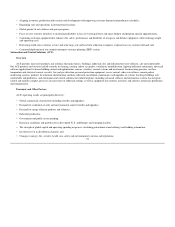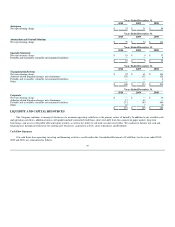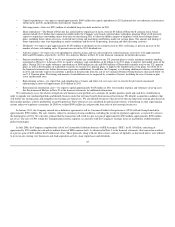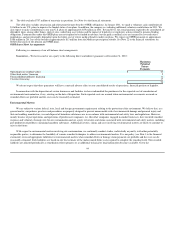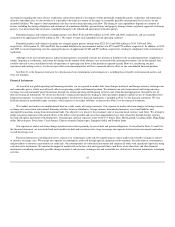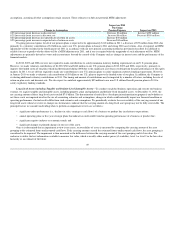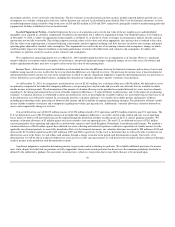Honeywell 2010 Annual Report Download - page 44
Download and view the complete annual report
Please find page 44 of the 2010 Honeywell annual report below. You can navigate through the pages in the report by either clicking on the pages listed below, or by using the keyword search tool below to find specific information within the annual report.
initiatives, we believe that our cash balances and operating cash flows will remain our principal source of liquidity. In addition to our available cash and
operating cash flows, additional sources of liquidity include committed credit lines, short term debt from the commercial paper markets, long-term
borrowings, and access to the public debt and equity markets, as well as our ability to sell trade accounts receivables.
A source of liquidity is our ability to issue short-term debt in the commercial paper market. Commercial paper notes are sold at a discount and have a
maturity of not more than 365 days from date of issuance. Borrowings under the commercial paper program are available for general corporate purposes as
well as for financing potential acquisitions. There was $299 million of commercial paper outstanding at December 31, 2010.
Our ability to access the commercial paper market, and the related cost of these borrowings, is affected by the strength of our credit rating and market
conditions. Our credit ratings are periodically reviewed by the major independent debt-rating agencies. As of December 31, 2010, Standard and Poor's (S&P),
Fitch, and Moody's have ratings on our long-term debt of A, A and A2 respectively, and short-term debt of A-1, F1 and P1 respectively. S&P, Fitch and
Moody’s have Honeywell's rating outlook as "stable". To date, the company has not experienced any limitations in our ability to access these sources of
liquidity. We maintain a $2.8 billion committed bank revolving credit facility for general corporate purposes, including support for the issuance of
commercial paper, which expires in mid-May 2012. At December 31, 2010, there were no borrowings or letters of credit issued under the credit facility. The
credit facility does not restrict Honeywell's ability to pay dividends, nor does it contain financial covenants. We expect to refinance the credit facility in 2011.
In the first quarter of 2010, the Company repaid $1,000 million of its 7.50% notes. The repayment was funded with cash provided by operating
activities.
In October 2010, we completed the acquisition of the issued and outstanding shares of Sperian Protection (Sperian), a French company that operates
globally in the personal protection equipment design and manufacturing industry. The aggregate value, net of cash acquired, was approximately $1,475
million, including the assumption of approximately $326 million of outstanding debt.
We also have a current shelf registration statement filed with the Securities and Exchange Commission under which we may issue additional debt
securities, common stock and preferred stock that may be offered in one or more offerings on terms to be determined at the time of the offering. Net proceeds
of any offering would be used for general corporate purposes, including repayment of existing indebtedness, capital expenditures and acquisitions.
As a source of liquidity, we sell interests in designated pools of trade accounts receivables to third parties. As of December 31, 2010 and 2009, none of
the receivables in the designated pools had been sold to third parties. When we sell receivables, they are over-collateralized and we retain a subordinated
interest in the pool of receivables representing that over-collateralization as well as an undivided interest in the balance of the receivables pools. The terms of
the trade accounts receivable program permit the repurchase of receivables from the third parties at our discretion, providing us with an additional source of
revolving credit. As a result, program receivables remain on the Company's balance sheet with a corresponding amount recorded as either Short-term
borrowings or Long-term debt.
We monitor the third-party depository institutions that hold our cash and cash equivalents on a daily basis. Our emphasis is primarily on safety of
principal and secondarily on maximizing yield on those funds. We diversify our cash and cash equivalents among counterparties to minimize exposure to any
one of these entities.
Global economic conditions or a tightening of credit markets could adversely affect our customers' or suppliers' ability to obtain financing, particularly
in our long-cycle businesses and airline and automotive end markets. Customer or supplier bankruptcies, delays in their ability to obtain financing, or the
unavailability of financing could adversely affect our cash flow or results of operations. To date we have not experienced material impacts from customer or
supplier bankruptcy or liquidity issues. We continue to monitor and take measures to limit our exposure.
In addition to our normal operating cash requirements, our principal future cash requirements will be to fund capital expenditures, debt repayments,
dividends, employee benefit obligations, environmental remediation costs, asbestos claims, severance and exit costs related to repositioning actions, share
repurchases and any strategic acquisitions.
Specifically, we expect our primary cash requirements in 2011 to be as follows:
41



